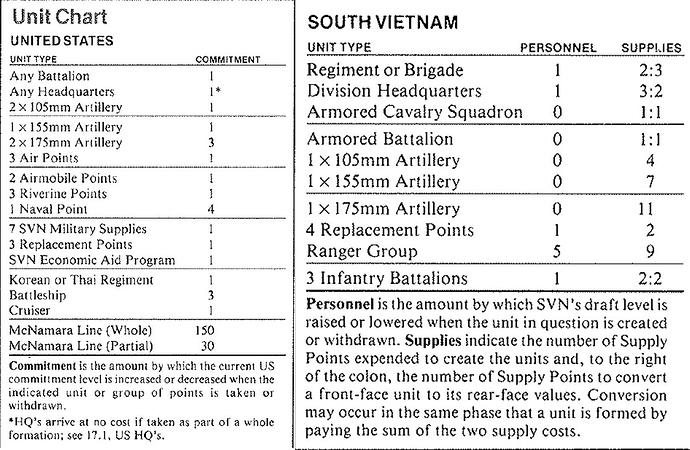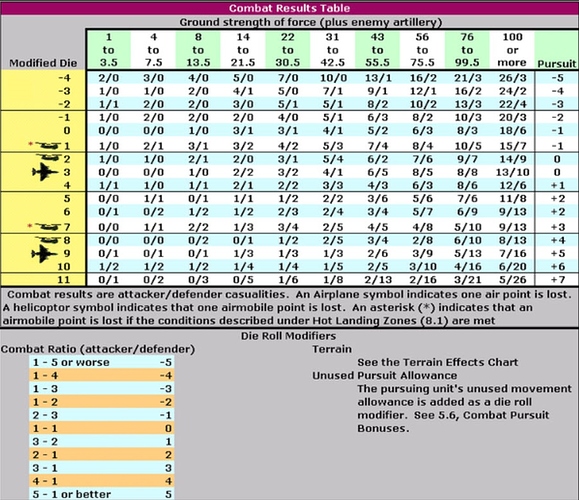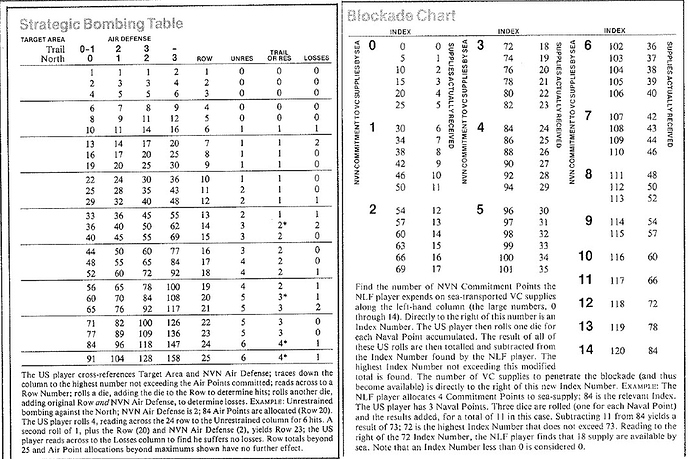Along Comes Mary
Vietnam 1965-1975
Comment Question Prompted Primer 1 - Builds, Air, and Air Defenses
In a new feature, Commenter Questions that merit exposition now get a song. Put on your flight (ear) goggles, please hit play before reading and turn to the maximum volume your brain or household will allow.
The Association. “Along Comes Mary.” Written by Tandyn Almer. Valiant, Warner Bros.. Released March 8, 1966. In the Billboard 100 all in the Spring, finally peaking at Number 7 in May.
So first lets throw these charts up.
Builds cost Commitment. US and NVN Builds are a straight up exchange of Commitment for a Unit, Replacement Points, Air Points, etc, as is evident above. The US can spend as much as it wants in any Interphase, subject to morale penalties for New Commitment. The NVN can spend up to their morale in Commitment. So if, for example, this Interphase, Curt’s NVN Commitment level was 60, well, after the Morale Phase, it’s now 77. So he could then spend 17 Commitment. He could buy NVA units, he could improve the Trail, he could improve Air Defenses (more later below) or he can send the Commitment South via the trail to be converted to VC Supply. It can also be sent as VC Personnel. More on those two topics soon.
ARVN cost Personnel and Supply. Personnel is provided by increasing the Draft Level. Right now that is 85. Max is the level of SVN Population Controlled. Right now that is 199. Supply is bought with US Commitment at 7 Supplies per 1 US Commitment Point.
All US or FWA Units or ARVN Builds must be placed in the entry ports (Hue, Da Nang, Chu Lai, Qui Nonh, Nha Trang, Cam Ranh Bay, Vung Tau, Saigon, My Tho or Can Tho).
VC cost Personnel and Supply. Supply is provided by sending commitment South the prior Interphase. So whatever Commitment Curt sent South (in Secret) in the Winter Interphase either can be sent down the Trail or via Sea Supply. He didn’t send any via Sea this Interphase so let’s talk Trail.
See the “optimal” and “effective” statuses of the Trail? See how it says “10/4”. 10 is the number of Supply conversion. So every Commitment Point sent gives him 10 VC Supply the next Season. Anything sent that season may be spent within 7 hexes of the Trail. Anything not spent goes into a Pool, where it can be spent anywhere in country the next Season.
Sea Supply is similar, it must be spent within 5 hexes of an all-sea hex the season it arrives. If not spent, it goes into the pool.
Another restriction on VC Supply is that only 2 supply or the level of population controlled in a province by the NLF (whatever is greater) can be spent on builds in any Recruitment Phase. The VC can build Supply Conduits (see the chart up there) that multiply this number by two. So they are then spending supply to be able to use more supply in a province when building.
The number to the right is the manpower conversion multiple. If the VC have outstripped their level of population controlled (currently 161, and I’ll bet you money that he has already surpassed that) then they may send Commitment South as Personnel for the VC. 1 Commitment Point gives 4 Personnel. To Start. Once the VC Draft level reaches 4 times the amount of population controlled that number on the Trail gets a -1 (so if that was today, it’d be 1:3). When it is 6 times the amount of population controlled that number on the Trail gets a +2 (if today, 1:2). 8 times? another -1 (1:1). So diminishing returns occur over time building the the VC. Eventually it becomes more cost effective to just build NVA. The VC still have utility in that they can be built “behind the lines”, but if attrition gets them to the 1:2 or 1:1 Manpower level, they just become too expensive to build, field and use as they were earlier in the game. Hence their role changes… Shorter term, the NLF still has to adjust anyway to using commitment for manpower in the first place. When it happens it usually causes an immediate “hiccup” in the NLF ability to field VC as the Commitment being received now has to be spent on Supply and Manpower. I think Curt is near this point.
How does he build? Physically, we end the Interphase after Morale online, I do my builds offline, send him a Vassal file, he does all his builds in private, and then I get the file again. If in person, I’d leave the room. If he is building VC Divisions, Regiments or Supply Conduits, he sees what he is getting. If its Battalions, he pulls them from a cup at random. So he says to hinmself, “I am building one Battalion in hex 4207”, pulls and places it. And then he can look at it.
He also gets 4 Political Sections for free each season. They can’t be bought.
Well, I see them as Commitment. So losing three means losing a Commitment Point. That’s the equivalent, in game terms, of the cost of a Battalion of Infantry.
Which is also my calculus for what represents what in the game when I write the history. 1 Commitment Point = 1 Battalion. If that is the case, 3 Air Points (1 Commitment Point) is one Squadron. 2 Airmobile Points (1 Commitment Point) is one Aviation Company. Each base cost translating into the basic unit of each capability in military terms.
It already has. Let’s look at Ground Support first.
Every Combat Result up there that has a plane next to it loses an Air Point if that number is rolled, if Air Points were used in that operation. Same for the Helicopter and Airmobile Points. Once one is lost in an Operation (not in an attack) no more can be lost. There is no tech versus tech here, the designer (Hi, Nick!) made the decision that at this scale, each side was changing TTPs and using new technologies in a way that don’t change the calculus there materially for Ground Support. At this scale. A decision I agree with wholeheartedly. These are Seasons with two Operational Turns in each (so basically six-week-ish Operational Turns). That is a loooong scale. Also, Battalion is he lowest level, and that’s really the US Units, and ARVN Indy Battalions or Arty. Most are Regiments in the game.
Now For Strategic Bombing/Air Defense, lets look at this table a bit more closely and keep in mind the Build Charts way up there in the post.
Look at the Top of the Chart. Each Air Defense Level above 0 costs 3 Commitment for Level 1, 4 for Lvl 2 and 5 for Lvl 3. This means, that at game start, the US almost has free rein to bomb Strategically, risking minimal losses. Each Level of Air Defense brings a more unfriendly table in terms of results, and require more Air Points be dedicated to the mission to get results. As well, after every mission against the Trail or North, The level of Air Defense is added to the loss roll. So lets say I bombed the North with enough Air to be on row 20 with ADF Level 0. That’d be 60 Air Points. At Level One it costs 70. Lvl 2, 84. Lvl 3, 108. So here the designer is reflecting that many more assets are required to achieve the same result based on increasing ADF capability and Technology. Curt is currently at Level One, by the way.
Oh and any result that I get that has an asterisk means an automatic Air Loss, apart from the losses roll.
Also, after I roll a 1d6 and add it to the row number and cross reference to see what effect I get, the NLF roll a 1d6 and do the same and compare it to the “Losses Column”. He also gets to add the ADF level as a modified. So at level 3, it’s be 1d6+3 added to the row level.
What the Designer is reflecting with this model is:
1.) the NVA had Aircraft, but many fewer than the US, and used as part of an ADF network.
2.) Technology and Tactics, Techniques and Procedures are a Cat and Mouse game and cancel each other out, but in the bigger picture more and better ADF means a greater risk of destroyed planes, dead pilots and degraded capability to inflict damage without a greater dedication of resources.
Does this answer your questions?





